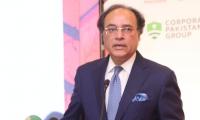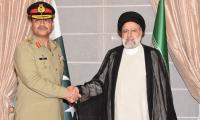The illuminated façade of the Frere Hall looked more majestic than usual on the midnight between Friday And Saturday . The reason for this was no extra visual element there but the musical notes of a raag in the air that was being performed by Ustad Fateh Ali Khan of the Gawalior Gharana, one of the best vocalists of the Indian classical music in the country right now, on the first day of the All Pakistan Music Conference.
The garden at the Frere Gall was supplied with chairs as well as daris and gao takia (bolsters) for those who wanted to relish the classical music in a relaxed posture. The audience was not in that large numbers as one would find in a pop or rock music concert — something expected given the general apathy of the people towards the supreme music of the subcontinent and ever declining aesthetic standards in the digital age. However, the attendants were still in a decent number that gave one the hope that the classical music would to continue in Pakistan.
It was however announced at the end of the first day that the conference, which was originally planned to last three days and end on Sunday, was reduced to two days and performances on Saturday night would culminate the event.
Fateh Ali was rightly the last performer of the day. He presented a khayal in quite a unique raag — Rageshree-kauns. As the name suggests, the raag was a hybrid melody containing the elements of Rageshree and Kauns.
As it was not a pure Rageshree, the raag did not offer that soothing feel of Rageshree, which has a pleasant romantic aura. With the mixture of Kauns, which could be considered a family of raags that include the sublime Malkauns, Rageshree-Kauns evoked a different feeling.
The maestro started the khayal with a slower tempo and ended the performance with a Tarana in the raag. Those who have little idea of classical music may think of Tarana as an anthem or a song, but in the context of the Indian classical music, Tarana means depiction of a raag using abstract words such as tana, dheem, dhir and yala that provide ease to the performer in unfolding the raag in a fast tempo called drut.
The fast tempo of tarana allowed the vocalist to exhibit taans, which is producing notes within the raag framework in a very fast manner.
There were also moments when he stopped singing after singing some taan to allow the sarangi or harmonium players to repeat his notes on their instrument, much to the delight of the audience.
It was also a pleasant sight to see young Gul Muhammad playing a difficult instrument like Sarangi comfortably with the maestro.
Fateh Ali also talked to the audience between the performance, something which many classical vocalists do. He said being in Sur was a must for a classical singer but they also needed to strictly follow the lay (tempo).
On one point, he made an interesting remark that he had not listened to the classical singers of India and Pakistan much as he did not want to consciously or unconsciously adopt their style. He said once someone in India told him that his singing style did not remind of any other singer.
Before Fateh Ali, the first day of the conference offered many other performances of raags, including both vocal and instrumental. One of them was a dhrupad performance by Labraiz Afzal and Ali Hafeez of the Talwandi Gharana, which is called the only Pakistan-based gharana of the Indian classical music as all other gharanas of the country have branches in India as well.
The Talwandi Gharana specialises in dhrupad, which was the chief genre of the northern classical music before the advent of Khayal.
Ustad Khursheed Hussain played Pakhawaj, the ancestor of tabla, in the dhrupad performance.
Turab Ali’s performance on sitar and Gul Muhammad’s another performance on Sarangi also delighted the audience. Another vocal performance was by Imran Ilyas, who sang Madhukons.
An aerial view of Karachi city. — AFP/FileCelebrating ShakespeareThe National Academy of Performing Arts is...
A representational image showing people taking part in a plantation drive in Pakistan. — UNAP website/FileKARACHI:...
A representational image of a gavel in a court. — Unsplash/FileAn anti-terrorism court has issued bailable arrest...
Two employees while working on a gas pipeline in an unidentified location. — AFP/FileThe SSGC disconnected gas...
Murtaza Bhutto brother of the then prime minister and Pakistan Peoples Party chief Benazir Bhutto . — Facebook/Mir...
CEO, KWSC Engineer Syed Salahuddin Ahmed pose for a photo at the KWSC office this image was released on March 12,...







